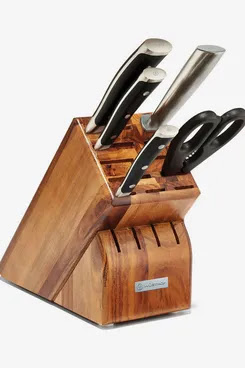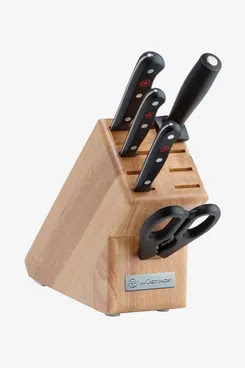The 6 Very Best Knife Sets
It's a generally expected saying that blades are an expansion of a cook's hand - yet while they are seemingly the main apparatus you can use in the kitchen, you want a couple of dependable ones to perform generally cutting, cleaving, cutting, deboning, and cutting errands. So that brings up the issue: Should you purchase each exclusively or all together? Clearly, the response isn't the last option on the off chance that you're simply missing a couple of explicit sorts. Yet, other than that, sets are fair game.
You can, as a matter of fact, find organized gatherings of various creations - three pieces as far as possible up to 20-something pieces, every one of culinary expert's blades or blended sorts, ones that incorporate honing apparatuses and squares and ones that don't. Assuming you've at any point perused the kitchen segment of any home-merchandise store, you realize that an arrangement with a great deal of pieces in it could appear to be at first engaging, however assuming that you look carefully, there are superfluous parts that will definitely go to bite the dust in your cutlery cabinet. The key is to ensure you don't wind up with a huge load of cutting edges and frill you won't utilize.
While conversing with specialists about their number one blade sets, I went with the suspicion that you're beginning totally without any preparation or re-trying the essential cosmetics of your assortment. Yet, obviously, assuming you like any of these brands, you can peruse the wide range of various groupings they bring to the table.
What we're searching for
Number of pieces: As I said previously, blade sets can accompany somewhere in the range of three parts of more than 20. For this story, I (and the specialists I addressed) inclined altogether toward the more modest finish of that range. I'm of the assessment that, more often than not, it's a good idea to purchase a more modest center gathering - a cook's blade, a paring blade, and a serrated blade - and afterward evaluate. Is it true or not that you are continuously wishing you had a subsequent culinary specialist's blade so you don't need to clean in the middle of errands? Does it divert out you'd profit from a boning cut since you eat fish and chicken several days per week? From your center gathering, you can continuously add on as you see what your genuine requirements are.
European-or Japanese-style: This arrangement is somewhat of an interesting one on the grounds that only one out of every odd blade falls particularly into one class or the other (and a few blades don't fall into by the same token). But then these terms are still normally utilized, the differentiations prominent enough that it's great to have a feeling of the fundamental attributes of each - particularly with regards to the culinary specialist's blade in every one of these sets. European-style is somewhat of a catchall term that is likewise alluded to as German-, French-, and Western-style. These are by and large heavier with a thicker, more bended sharp edge to work with shaking to and fro with the tip down on your cutting board. Then again, Japanese-style blades will generally be lighter with a more slender sharp edge and a straighter edge to work with outrageous accuracy. To make things considerably seriously befuddling, some Japanese organizations make European-style blades and a few European and American organizations make Japanese-style blades. In any case, here I've meant the style of each actually surprisingly well and afterward meticulously described the situation in the portrayals.
Six pieces | European-style
Wüsthof is an exemplary organization. The one cook and Top Chef Canada have Eden Grinshpan was told to purchase when she was in culinary school, the one cookbook writer Erin Gleeson enrolled for when she got hitched 10 years prior regardless purposes, and the one liked by various superstar gourmet experts with shifting cooking styles (a speedy Google search will let you know that both Ina Garten and Gordon Ramsay depend on them). "They're simply superhigh quality, and they truly endure over the extreme long haul," Grinshpan says. "I actually have a portion of the pieces in my kitchen." This specific set accompanies a paring blade, a gourmet specialist's blade, and a serrated blade - the main three you truly need when it comes down to performing most cooking errands, as I made sense of previously. It likewise incorporates some supportive (not unnecessary) extras: a wooden square to hold your cutting edges securely, a sharpening steel to hone the edges, and a couple of "fall to pieces" kitchen shears (the "break apart" makes them simple to clean). "I utilize the scissors constantly," Gleeson says, "for cutting everything from pizza and flatbreads to scallions."
Six pieces | European-style
This more reasonable set from Wüsthof has a comparable arrangement. The paring blade is a half-inch more modest (which shouldn't have any observable effect), the serrated blade is three inches more modest (a utility blade planned to cut things like tomatoes rather than hard bread), and the square is produced using an alternate assortment of wood (beechwood rather than acacia). Most quite, the blades are stepped (cut from one huge sheet of steel) rather than manufactured (produced using a solitary bar of steel that is warmed and afterward beat into shape the hard way or machine). This makes them not exactly as solid yet a lot less expensive - and they can thoroughly get the job done (and do it admirably), particularly in the event that you're not especially unforgiving with your blades.
Three or five pieces | Combination Japanese-and European-style
"I truly like these blades as worth purchases," says Jeff Strauss, proprietor and gourmet expert of Jeff's Table in Los Angeles. "Something blade geeks talk about is steel hardness, and these are on the harder finish of bendy, which is a perfect balance." As he makes sense of it, they're hard to the point of honing effectively and they hold an edge well indeed. Yet, they're not hard to such an extent that they move in a crazy manner that can take some becoming acclimated to - you can feel the distinction with a superhard edge and now and again even break it assuming you make some unacceptable developments. "I know a lot of ace cooks who utilize these," he says. "I have six of them. You don't need to be as well, excessively valuable."
The cost is a selling point for Strategist supervisor Maxine Builder as well. A couple of years prior, she tried a lot of DTC cookware and named Misen the best blade set. "As far as I might be concerned, Misen's three-piece Essential Set is the Platonic ideal of a blade set, and assuming that you're searching for a Wüsthof hoodwink, this is all there is to it," she composed. "They're heavier than my Global blades, as most European-style blades are … and the edges have held as sharp as the primary day, even following a couple of long periods of purpose." The greatest disadvantage to Builder was the handles have somewhat of a square shaped shape (what Strauss says is to some degree a French style), however she said that with a value tantamount to one of those "large blade block sets you can get at Target or Amazon," they're a "huge redesign."
You can go with three pieces (a gourmet expert's blade, a paring blade, and a serrated blade), or five pieces (an extra utility blade and a Japanese-style santoku blade with a straight edge).




Comments
Post a Comment